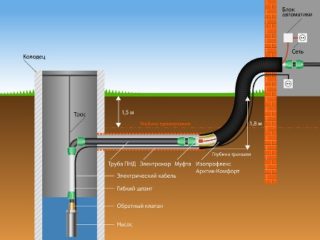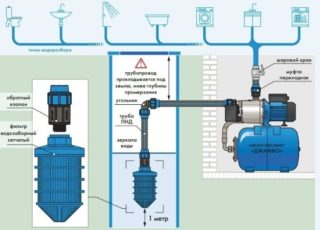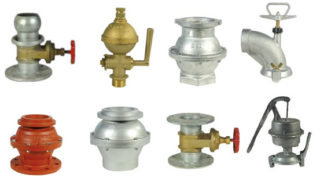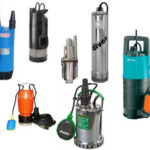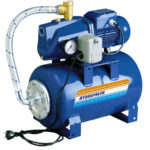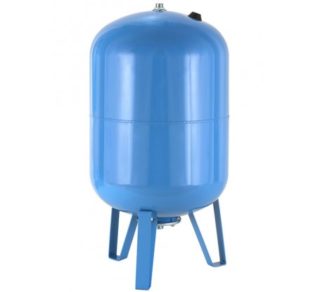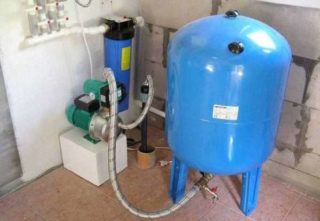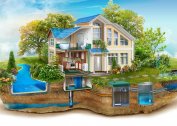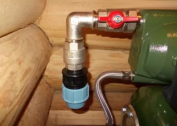The main advantage of an autonomous water supply network is that the owners of suburban estates do not face the problem of lack or insufficient amount of water. To make a water supply system at the cottage from the well for everyone, besides the same source for one site does not necessarily have a large debit.
Water supply in the country from the well through the pumping station
The well, as a source of an autonomous water supply system, equipped with a pumping station or a submersible / surface pump, has a number of individual features.
- In comparison with the well, the well has a large shaft diameter, which allows you to easily install powerful and reliable submersible pumps, dismantle them with ease, carry out maintenance and repairs if necessary.
- Well water contains a lower concentration of harmful impurities, however, in order to continue the system's operational life and use clean water, it is recommended to additionally equip the system with a coarse filter.
- The advantage of such a source is also that homeowners can manually extract water using a bucket during a power outage.
- It is much simpler to preserve the system than, for example, wells. This is due to the unhindered installation and dismantling of equipment.
A characteristic feature of wells - with proper drilling and construction, they have less siltation and sanding than wells.
Designing an Autonomous Water Supply System
Preliminary design and planning of works that are associated with the arrangement of a summer cottage or a country house is always a significant saving of one's own forces, time and financial costs.
Before purchasing all the necessary equipment, it is important to draw up a site plan with the mandatory designation of all objects. The water supply scheme at the cottage from a well with a submersible or surface pump will allow you to calculate the exact distance from the point of intake to the water taps.
To collect all the information, it is necessary to use the tape measure to measure the entire route of the future water main, take into account each turn, the proposed inset and node. Thanks to this approach, it will be possible to calculate the approximate footage of pipes, as well as other connecting elements: couplings, fittings and adapters.
First you need to think about how the points of consumption of the water resource will be arranged. Most often, the following methods are practiced:
- Installation of individual communication nodes with taps that lead, for example, to a summer kitchen, bathhouse, etc.
- Inside the house - installation of plumbing equipment, connecting the accumulator - a tank designed to store water.
- Outside - the installation on the plot of several hydrants designed for ease of irrigation.
For a ground-based system, the safest and at the same time shortest path should be considered, for example, along fences, storm channels, paths, etc. The underground structure also includes mandatory earthwork, which requires additional calculations.
When installing a year-round water supply system, it is important to consider not only the length, but also the depth of the pipes in the trenches on a flat area.The optimal occurrence depth varies between 30-80 cm, depending on the level of soil freezing with the advent of cold weather.
The diagram indicates the location of the tap to drain the water. As a rule, this is the longest part of the laid communications. It is important to ensure unhindered access to this site, since with the advent of cold weather the water supply system is often subject to conservation.
Having completed all the calculations, and schematically depicting all the nuances, you can start work - digging trenches, acquiring all the necessary equipment.
Necessary tools and materials
First of all, you need to determine the type of pumping equipment used. You can purchase a pumping station or a submersible pump. Experts always advise giving preference to deep (submersible) devices. This is due to high performance, power, low noise and long life. The necessary modification is selected based on the depth of the water mirror.
- Well submersible pumps
- Pump station Pedrollo JSWm 1AX
Any scheme of a water supply system includes:
- A hydraulic accumulator is a device whose main task is to protect the entire system from a possible water hammer, as well as maintaining optimal pressure in the pipeline. The accumulator tank accumulates water, therefore, when there is a power outage, there will be no problems with the water supply. The volume of the tank may be different.
- A drain valve is a small part that is installed at the lowest point of the entire system. It is used to drain water during the preservation of the system for the winter.
When conducting a water supply system on a household plot, pipes (metal or polypropylene), fittings, a strainer, connecting elements, taps, mixers, brackets, valves will be required.
A set of keys, a grinder, a punch and a gas key are required for work.
Installation and Connection
The construction of a water supply system takes place in several stages:
- System design. The acquisition of all necessary equipment, tools and other supplies.
- A year-round system requires digging trenches. Their bottom is rammed with a layer of sand and gravel.
- Pipe laying
- Installation of a hydraulic accumulator and pumping equipment.
- The connection of the accumulator with the pumping station, their connection to the pipe.
- Insertion of the intake pipe into the well shaft.
- Piping layout indoors.
All work is carried out using special overhangs - short pipes equipped with threads on both sides. Connection to pipes is carried out using flanges or fitting adapters.
In order to prevent the occurrence of leaks in the future, the joints are carefully treated with special sealant compounds. Pipes made of their polyethylene are connected by adhesions or fittings. The joints are also additionally treated with sealant. When working with polyethylene pipes, it is strictly forbidden to use mastic and bitumen.
Features of operation and maintenance
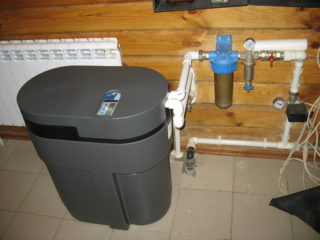
A properly selected, installed, and regularly maintained system rarely fails. To prevent breakdowns, it is important to periodically carry out preventive measures.
- Pumping equipment - you need to regularly monitor the performance and operation of the equipment, timely change all consumables, for example, rubber gaskets.
- Filters - the use of purification filters for rough cleaning allows solids to be separated from well water, this improves the composition of the water and favorably affects the operation of the entire autonomous water supply system.
- Sealing. In case of deterioration in water quality, it is necessary to check the sealing of the casing stitches of the well.
- Observe the working pressure in the pipeline. Allowed parameters are from 2.5 to 4 atmospheres.
Summer plumbing is cheaper than year-round. However, the latter has a list of disadvantages. First of all, every year there is a need to install and then dismantle the pipeline network, otherwise in the winter it will freeze and fail.
Prices for a summer water supply at the cottage from the well, depending on the depth of the source and the area of the personal plot, range from 5000 to 15000 rubles. When arranging a year-round highway, temporary, physical and financial investments increase significantly.
